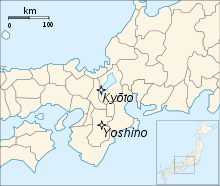Bunna
| History of Japan |
|---|
Bunna (文和), also romanized as Bunwa, was a Japanese era name (年号, nengō, lit. year name) of the Northern Court during the Era of Northern and Southern Courts after Kannō and before Enbun. This period spanned the years from September 1352[1] through March 1356.[2] The emperor in Kyoto was Emperor Go-Kōgon (後光厳天皇).[3] Go-Kōgon's Southern Court rival in Yoshino during this time-frame was Emperor Go-Murakami (後村上天皇).
Nanboku-chō overview
During the Meiji period, an Imperial decree dated March 3, 1911 established that the legitimate reigning monarchs of this period were the direct descendants of Emperor Go-Daigo through Emperor Go-Murakami, whose Southern Court (南朝 nanchō) had been established in exile in Yoshino, near Nara.[4]
Until the end of the Edo period, the militarily superior pretender-Emperors supported by the Ashikaga shogunate had been mistakenly incorporated in Imperial chronologies though it was acknowledged that the Imperial Regalia were not in their possession.[4]
This illegitimate Northern Court (北朝 hokuchō) had been established in Kyoto by Ashikaga Takauji.[4]
Change of era
- 1352, also called Bunna gannen (文和元年): The new era name was created to mark the accession of Emperor Go-Kōgon. The previous era ended and the new one commenced in Kannō 3.[5]
In this time frame, Shōhei (1346–1370) was the Southern Court equivalent nengō.
Events of the Bunna era
- 1352 (Bunna 1, 11th month): The grandfather of the emperor is advanced from the rank of dainagon to nadaijin.[5]
- 1353 (Bunna 2): Kyoto occupied by southern forces under Yamana Tokiuji; and the capital was retaken by the Ashikaga.[6]
- 1354 (Bunna 3): Takauji flees with Go-Kōgon; Kitabatake Chikafusa dies.[6]
- 1355 (Bunna 4): Kyoto taken by southern army; Kyoto retaken again by the Ashikaga forces.[6]
Notes
- ↑ Nussbaum, Louis-Frédéric. (2005). "Bunwa" in Japan encyclopedia, p. 93; n.b., Louis-Frédéric is pseudonym of Louis-Frédéric Nussbaum, see Deutsche Nationalbibliothek Authority File.
- ↑ Nussbaum, Louis-Frédéric et al. (2005). "Embun" in Japan encyclopedia, p. 175; n.b., although Nussbaum identifies 1355 as the end of this era, its successor begins in March 1356 per NengoCalc
- ↑ Titsingh, Isaac. (1834). Annales des empereurs du japon, pp. 302-303; Nussbaum, p. 175.
- 1 2 3 Thomas, Julia Adeney. (2001). Reconfiguring modernity: concepts of nature in Japanese political ideology, p. 199 n57, citing Mehl, Margaret. (1997). History and the State in Nineteenth-Century Japan. p. 140-147.
- 1 2 Titsingh, p. 302.
- 1 2 3 Ackroyd, Joyce. (1982) Lessons from History: The Tokushi Yoron, p.329.
References
- Ackroyd, Joyce. (1982) Lessons from History: The Tokushi Yoron. Brisbane: University of Queensland Press. ISBN 978-0-7022-1485-1
- Mehl, Margaret. (1997). History and the State in Nineteenth-Century Japan. New York: St Martin's Press. ISBN 978-0-312-21160-8; OCLC 419870136
- Nussbaum, Louis Frédéric and Käthe Roth. (2005). Japan Encyclopedia. Cambridge: Harvard University Press. ISBN 978-0-674-01753-5; OCLC 48943301
- Thomas, Julia Adeney. (2001). Reconfiguring Modernity: Concepts of Nature in Japanese Political Ideology. Berkeley: University of California Press. ISBN 978-0-520-22854-2; OCLC 47916285
- Titsingh, Isaac. (1834). Nihon Odai Ichiran; ou, Annales des empereurs du Japon. Paris: Royal Asiatic Society, Oriental Translation Fund of Great Britain and Ireland. OCLC 5850691
External links
- National Diet Library, "The Japanese Calendar" -- historical overview plus illustrative images from library's collection
| Preceded by Kannō |
Era or nengō Bunna 1352–1356 |
Succeeded by Enbun |
